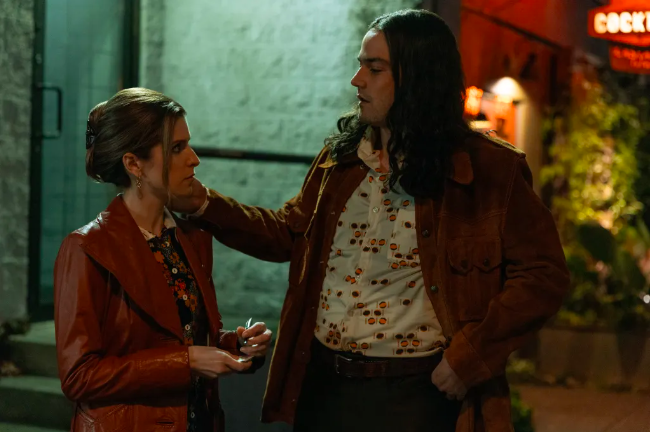
Woman of the Hour
A captivating directorial debut.


© Leah Gallo/AP
Although I’m a little late to the conversation, Woman of the Hour has occupied my thoughts ever since I watched it. I can’t remember the last time a film immersed me as completely as this one did. From the very first scene, the unsettling feeling gripped me, and the 80-minute runtime flew by as I watched with bated breath, eagerly awaiting the outcome of this haunting and tragic true story. But what struck me even more were the shocking realities of how women were treated during this time period. These behaviours were portrayed as the norm, or even expected, which felt especially frustrating and unsettling given the political climate today, where women’s rights continue to be under threat across the world.
When I’m in the right mood, I’m definitely a fan of true crime, which is probably why I hadn’t gotten around to watching this sooner. But when the time came, I was ready to dive into the awful details of the case. After seeing the film, I was astounded that I hadn’t heard of Rodney Alcala before. His lengthy and prolific killing spree, which is suspected to have claimed up to 130 victims, is chilling. The film doesn’t gloss over the full extent of Alcala’s crimes (or his bizarre appearance on a national television dating show) which makes his ability to deceive and manipulate all the more terrifying. Each new encounter he has with a victim is spine-chilling, and you’re left pleading for the women to escape.
Many of the creative choices felt purposeful and thoughtfully executed. One of the highlights for me were the close-ups on the victims' facial expressions and body language, which powerfully conveyed the women’s emotions. These subtle details, though easy to overlook, highlighted the experiences of these women whose stories often go unheard. The film’s decision to show their struggle only up until the point where unease turns to outright fear left the audience teetering on the edge of discomfort, unable to fully intervene but deeply empathising with the women who realise, far too late, the true danger they’re in.
Much of this emotional depth can be credited to Anna Kendrick, both in her performance as Sheryl Bradshaw, the bachelorette from Alcala's episode of The Dating Game , and in her directorial debut. Her direction conveys an urgent and clear message from women, to women, igniting a fury and strength to continue fighting violence against women. This message became even more apparent after I learned that Kendrick donated all the proceeds she earned from the film to charities supporting victims of violent crime and sexual assault. It’s clear that her commitment to the story goes beyond filmmaking, and that dedication only strengthens the film’s impact.
I also learned from Kendrick’s social media that the film was shot in just 24 days, which feels like an impressive feat given the scope of the story and the number of settings involved. That compressed timeline is a testament to the efficiency and focus behind the production, and it makes the film all the more remarkable.
That said, my main critique of Woman of the Hour is that the film sometimes feels episodic in its structure, which might have worked better as a mini-series, much like Monsters: The Lyle and Erik Menendez Story. The connection between Sheryl Bradshaw’s story and Rodney Alcala’s many victims loosely ties together the narrative, but it may have been more impactful if each victim’s story had been given more time to develop. This would also have allowed room to explore more of Alcala’s victims, as the film only highlights a few - overlooking that some were as young as 8 years old. It’s unclear how the filmmakers chose which victims to focus on, but I’m curious to know more about that decision.
Despite this, the standout moments in the film come during the tense encounters between Alcala and his victims. Anna Kendrick as Sheryl, along with Autumn Best as Amy, Kathryn Gallagher as Charlie, Kelly Jackle as Sarah, and Nicolette Robinson as Laura, each deliver emotionally powerful performances in a short amount of screen time, making their stories resonate deeply. Daniel Zovatto’s portrayal of Rodney Alcala is equally compelling, capturing the dual nature of a man who is charming enough to lure his victims, but twisted enough to inflict unspeakable harm. Zovatto’s portrayal also subtly hints at Alcala’s unraveling, especially in moments where his attempt to cover his tracks suggests a glimmer of regret, or at least fear of getting caught. The moments that really stuck with me, however, was firstly between Kendrick’s Sheryl and Zovatto’s Alcala, when she lies to escape his increasingly dangerous advances. The intensity of that scene - where the tension between them is palpable and we, along with Sheryl, are desperately hoping for her safety, definitely left me with a lump in my throat. The second was from Nicolette Robinson whose bubbling anger as she continually goes unheard and ignored amounted in a scene at the police station where she can no longer accept the maltreatment of her friend as a victim and herself as a witness in not being taken seriously and seeing this known murderer walk free. Her depiction of this aspect of the story in particular was disheartening and emotionally draining as a viewer.
Woman of the Hour feels particularly timely, given the ongoing fight for gender equality and the continuing prevalence of violence against women. The film’s focus on the experiences of women from 50 years ago is still strikingly relevant today, and it serves as a reminder that these issues are far from resolved. This makes the film’s message even more urgent and necessary in the context of current global conversations around gender and violence.
Overall, I think Woman of the Hour is one of the best entries in the true crime genre in recent years. It accomplishes what it sets out to do, sparking much-needed conversation about the haunting realities of Rodney Alcala’s crimes, while highlighting the ongoing fight for women’s safety and rights as well as the many cases of others that may go unresolved, ignored or forgotten. I also hope that this film marks just the beginning of Anna Kendrick’s career behind the camera. Her directorial debut was powerful, thought-provoking, and deeply relevant, and I look forward to seeing what she tackles next.
